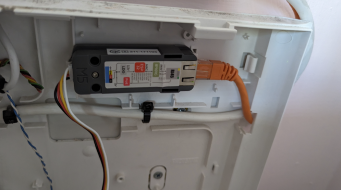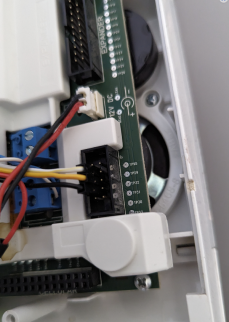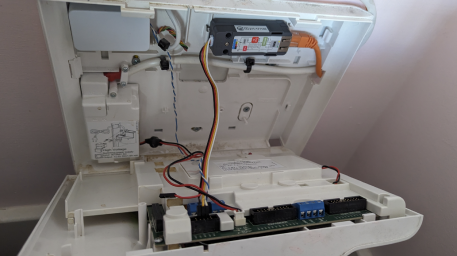Using M5Stack ESP32 Ethernet Unit with POE M5Unit PoESP32 - davesmeghead/visonic GitHub Wiki
Using M5Stack ESP32 Ethernet Unit with PoE (M5Unit-PoESP32)
In this guide I'll walk you through the required steps to use a M5Stack ESP32 Ethernet Unit with POE (M5Unit-PoESP32) between a PowerMax/PowerMaster and Home Assisant.
The M5Stack PoESP32 Unit is an ESP32 Ethernet Unit that supports PoE (Power Over Ethernet). This module adopts an ESP32 as a built-in MAC and IP101G as a physical layer transceiver.
The unit has default firmware with ESP-AT that we will replace with ESPHome.
Disclaimer
I'm not responsible for bricked devices, dead alarms or short circuits.
- You are choosing to make these modifications, please don't point the finger at me for messing up your device.
- Your Visonic Warranty will (possibly) be void if you tamper with any part of your device / software.
Why choose an M5Stack ESP32 Ethernet Unit with POE (M5Unit-PoESP32)?
Advantages:
- More reliable than Wifi in unreliable locations
- It is supported by ESPHome
- Has a Serial UART onboard (for the RS232 panel connection)
- Only needs 1 external cable and is Powered over Ethernet (PoE)
- Provides an elegant and simple install, it fits neatly inside the alarm housing.
Dis-advantages:
- It is fairly low cost but certainly not the cheapest option (~30 GBP)
- Requires additional equipment PoE power/switch. Unless you already have them!
Hardware
- M5Stack ESP32 Ethernet Unit with PoE (M5Unit-PoESP32). Available from thepihut.com or other vendors
- M5Stack Grove2Dupont Conversion Cable. Available from thepihut.com or other vendors.
- A PoE switch or a PoE injector that supports 802.3AF. Available from amazon.co.uk
- USB to TTL/Serial Adapter. Many different models available, I tried several DSD Tech models but only had success after using this one amazon.co.uk
- Male to Female jumper wires. Many different oens available eg. amazon.co.uk
Install Python and the ESPHome packages
On Windows:
- Install python. At the end of the install don't forget to tick
Add Python to the PATH - Install esphome
pip install -U esphome
On Mac:
brew install python
python3 -m pip install --upgrade pip
pip3 install -U esphome
Download visonic.yaml and secrets.yaml
- Download visonic.yaml and secrest.yaml here
- Unzip the file
Update secrets.yaml
You only need to retain the following:
network_port: 10077 # The port that you connect the Visonic Integration to
panel_baud_rate: 9600 # The baud rate of the serial port on the alarm panel. As per the wiki
device_password: "123456789" # This is the password for the ESPHome API, please change it. You need this when you setup ESPHome in Home Assistant
Update visonic.yaml
substitutions:
plug_name: "visonic"
esphome:
name: ${plug_name}
friendly_name: ${plug_name}
esp32:
board: m5stack-core-esp32
external_components:
- source: github://oxan/esphome-stream-server
# Enable logging
logger:
# Disable logging
logger:
level: DEBUG
baud_rate: 0 # disables logging to the serial UART (as we are using it for other things)
# Enable Home Assistant API
api:
password: !secret device_password
ota:
password: !secret device_password
uart:
id: uart_bus_visonic
baud_rate: !secret panel_baud_rate
tx_pin: 17
rx_pin: 16
stop_bits: 1
data_bits: 8
parity: NONE
debug:
direction: BOTH
dummy_receiver: false
stream_server:
id: my_stream
uart_id: uart_bus_visonic
port: !secret network_port
ethernet:
type: IP101
mdc_pin: GPIO23
mdio_pin: GPIO18
clk_mode: GPIO0_IN
power_pin: GPIO5
phy_addr: 1
Install ESPHome on the M5Unit-PoESP32
This is where things get a little bit tricky, unless you are an Octopus. You may also want to read the guidance here
- Disassemble the M5Unit-PoESP32
- Connect the pins on the M5Unit-PoESP32 to the USB serial adaptor (with the USB disconnected).

- Use your thumb to apply side pressure to the plug that goes into the poesp32 to ensure they make contact
- Use a finger to hold the fly lead on G0
- Use the rest of your fingers and spare hand to plug in the USB device
- Use your spare hand to run the esphome commands:
python -m esphome visonic.yaml run - Select/confirm the
COMport, ESPHome will then attempt to connect to the device - If you have done it correctly you should see
TXandRXflash and ESPHome should be logging out lots of positive messages - On completion, plug the M5Unit-PoESP32device into a network port with
POE, check it appears on the network.
Install the M5Unit-PoESP32 Unit into your alarm
- Connect the Grove2Dupont cable (Groove to female) to the POESP32 device
- Attach a network cable and place the M5Stack POESP32 device into the spare slot on the wall mount bracket, it is slightly too tigher but will just about fit

- Connect the white, yellow and black Grove2Dupont connectors to the 3 pins on the alarm. Tuck the red cable out of the way (not needed)

- You should end up with something like

- Place the alarm back on the wall.
Note: If you have an issue with the Tamper Alarm that won't go away, remove the power supply to the Alarm along with the battery connection and then re-attach the device to the wall ensure you hold the bottom of the alarm while you screw it back in to ensure it doesn't come back.
Install Visonic Integration in to Home Assistant
- Navigate to Home Assistant and check that your new device has been detected by ESPHome.
- Install the custom integration "Visonic"
- Add the visonic integration and use Ethernet as the connection type:
- Use the IP address "network_ip" that you put in your secrets.yaml
- Use the port "network_port" that you put in your secrets.yaml
- This should create the alarm panel